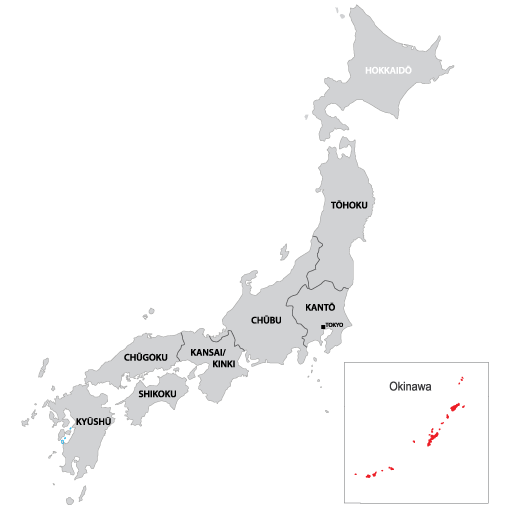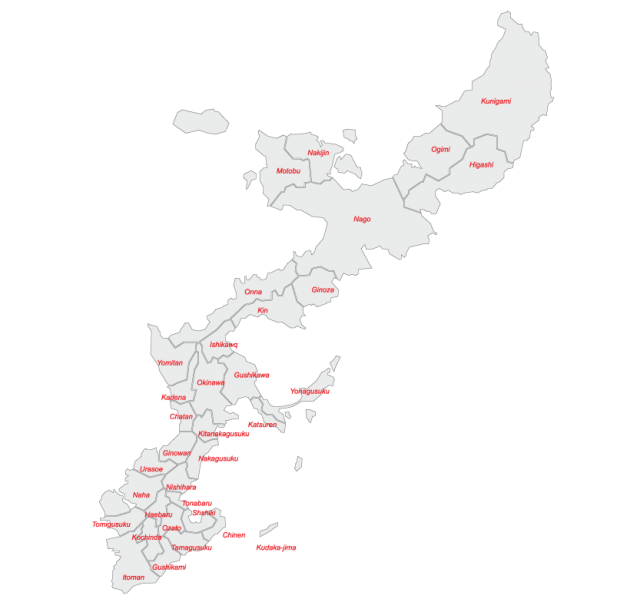

Okinawa prefecture, Japan’s tropical paradise, consists of 160 islands stretching across the ocean, 49 of which are inhabited.
Some of these islands lie closer to Taiwan than they are to the mainland of Japan and the distribution of the islands is vast and they stretch 1000km across the ocean. Today Okinawa is home to 1.4 million people. The islands of Okinawa have their roots in the Ryukyu kingdom, and over the centuries have been influenced as much by Asia due to their position, as by China. The strategic position of the islands of Okinawa led them to be the location of fierce battles during World War II, a legacy of which is the presence of a number of US military bases on the island.
Many who visit Okinawa are searching for beaches and sunshine, both of which are plentiful in Okinawa due to the subtropical climate. The island is also well known for its diving and for all kinds of enjoyment of water sports – sea kayaking, SUP, snorkelling, sailing, surfing, and fishing. The rich history of the area and its unique cultural traditions provide some interest for those seeking more. The weather in the islands stays pleasantly warm throughout the year, with more rainfall in September and October during the typhoon season. Many of the islands of Okinawa have wild sub-tropical jungles.
Okinawa is also one of the world’s ‘blue zones’ where residents enjoy living to a ripe old age. Whether this is due to the relaxed island lifestyle, or the local diet is unknown, but in a country where it is not uncommon for people to reach their 90s or even 100, this is even more common in Okinawa.
Karate is a fighting technique using various kata or movements and originates in Okinawa. Those with an interest may wish to visit the Karate Kaikan in the southern part of the island. There is also a training centre in the Murasaki Mura complex.
Okinawa is a relatively recent addition to Japan. Until 1609, the Ryukyu Kingdom was independent, and its people were known as locally powerful sea traders. Even though the Satsuma rulers took over the islands at that time, Ryukyu influences remained strong. In the Meiji era, the islands were subjected to policies of forced linguistic assimilation, and Japanese control over the islands tightened.
During World War II, the Okinawa Islands were a militarily strategic location, lying between broader Asia and Japan, and the islands and their people suffered heavily, with over 120,000 residents perishing throughout the war. With the US victory the islands came under US occupation until 1972, bringing a number of American influences to the islands. The US military bases that remain on the island today are a legacy of that occupation and their ongoing presence remains controversial.
Okinawa Island (the ‘Main’ Island)
Okinawa’s largest island, referred to as the ‘Main’ island because it is the largest island in the archipelago and the most populous, is divided into three zones – the Northern Island, the Central Island, and the Southern Island. The Ryukyu kingdom ruled from the main island, and today it remains a hub for reaching the outlying islands of Okinawa.
Naha is the largest city on the main island and is the starting point for many visits to Okinawa as it is home to Okinawa’s largest airport. The central route through the city – Kokusai Dori – is located near a market and is lined with shops and restaurants that serve the needs of visitors and residents alike. The Shuri area was once the central seat of the Ryukyu kingdom, with Shuri-jo, the castle, at its heart. This UNESCO World Heritage site, thought to have been built in the 13th or 14th century, was recently destroyed in a fire, but is being rebuilt after the original. The city’s Shikinaen Garden was another residence of the Ryukyu kings and was where delegations from China, a key trading partner of the kingdom, were received. The city’s pottery traditions are kept alive on Tsuboya Yachimun Street. Naminouegu Shrine served the spiritual needs of the Ryukyu kingdom.
Naha sits in the southern portion of Honto, or the main island. The island south of Naha is largely rural today, but was once an important site, with traces left behind in the ruins of Gushikawa Castle. The tropical turquoise waters are overlooked by sugarcane fields, and those seeking beautiful beaches need to look no further than Mibaru Beach. The Ryukyu creation stories place this part of the island as the location where the Gods descended to the earth, and Sefa Utaki is still an important spiritual site to islanders and is also a UNESCO World Heritage Site. This part of the main island faced fierce fighting during World War II. The Peace Memorial and the Himeyuri Peace Museum commemorate those lost in the war as well as the female students mobilised as nurses and their wartime experience. The limestone caves of the southern part of the island formed part of that experience, and you can discover the Gyokusendo caves here at Okinawa World – a theme park that introduces Okinawa’s cultural traditions to visitors.
Central Island
The Central island exemplifies the tension between local and imported influences. The US military bases on Okinawa are in the island’s central portion. US fast food chains and some stores have outposts here and more signs appear in English. The Mihama American Village offers a number of imported US items for sale. Ginowan, Chatan, and Kadena are the focus of these bases.
At the same time, a number of sites seek to preserve Okinawan traditions and showcase these to visitors. The Yomitan Pottery Village brings together a number of potters to continue practising their craft. The Yomitan Traditional Crafts Centre showcases traditional weaving styles. Murasaki Mura, which also offers karate training, also offers an opportunity to try a number of different Okinawan experiences. If you wish to walk in the footsteps of the Ryukyu kings, the UNESCO World Heritage ruins of Zakimi Castle allow you to do so while looking out over the South China Sea. Traditional crafts such as pottery and bingara dyeing, sanshin music, and eisa dancing are all on the program. If you would like to learn more about eisa dancing, the lively traditional dances that are associated with ancestor worship, and O-bon in the area, visit the Eisa Museum.
Northern Island
The Northern Island, north of Nago, is wilder and more remote, with low mountains in the Yanbaru inland area. The sub-tropical forests of Yanbaru are popular with birdwatchers wishing to spot the Okinawa rail, a flightless bird found only in this area. The Yanbaru National Park is home to a number of rare flora and fauna. On the coast, holiday resorts overlook some of the area’s beautiful beaches, but it is still possible to find remote beaches with few visitors. The Okinawa Churaumi Aquarium showcases the diversity of the seas of Okinawa – with brightly colored tropical fish. It lies at the heart of the Ocean Expo Park. The Ryukyu rulers extended this far north and the Nakijin Castle Site offers particularly well-preserved ruins of the 13th Century castle which was one of the largest gusuku castles in the region.
Kume Island
Kume Island lies West of the main island of Okinawa and is considered to be one of the most beautiful in the archipelago. Shirahama beach and Eef beach are highlights on the island, and from Eef beach, low tide exposes the unique rock formations on the coast known as tatami ishi or tatami rocks – so called for their flat square shapes reminiscent of tatami mats. The Nibuti forest lies within the Ramsar wetlands area of the island.
The island was an important part of the Ryukyu kingdom and profited greatly from trade with China. Castle ruins dot the island, vestiges of this history. For those that want their beach to be fully surrounded by the sea, you may wish to join a tour to the 7 km long Hatanohema sandbar, where the ocean lies on all sides.
Kerama Islands
Of the islands of the Keramashoto National Park, most are uninhabited, with the exceptions of Tokashiki, Zamami, Aka, and Geruma. As with most of the islands in Okinawa, the Kerama islands offer beautiful beaches and opportunities to engage in water sports. The area is so well known for the bright blues of the ocean that they have been named ‘Kerama blue’. Zamami Island is also a good location for whale watching from winter to early spring. The coral reefs found here are also a draw for divers. Sea turtles can also be seen in the waters off the islands of Tokashiki, Zamami, and Aka. Aka island is also known for its crystal clear waters.
Miyako Islands
The Miyako Islands are a firm favourite of those seeking Okinawa’s famous tropical beaches, providing a real getaway from the cities. The islands are accessed by air and Miyako Island is the main transport hub for this chain of the Okinawa islands. Aragusuku beach is prime snorkelling territory for spotting colourful fish. Yonaha Maehama Beach is wonderful for sunbathing or watersports with similarly sparkling white sands and bright tropical seas. Divers are particularly attracted by the many underwater caves waiting to be explored. Bridges connect Miyako island to the nearby islands of Irabu, Ikema, and Kurima.
The island’s underwater seascape is revealed at the Miyakojima Underwater Park, with panels viewing out onto the seabed. Unique plants of the island and the subtropical area of Japan collect and thrive at the Miyakojima City Tropical Botanical Garden. In the summer and early autumn months, Okagani crabs flock to the beach to spawn during the full moon, and then return inland in a natural parade.
The Ikema marshlands are a favourite of birdwatchers trying to spot buzzards and ospreys. The entirety of Ikema is a wildlife protection area.
Irabu Island has just 6000 residents, but kilometres of white sand beaches. Toguchi no Hama beach itself is a kilometre long and perfect for rest and relaxation away from the crowds. From Irabu island, the bridge continues to Shimoji Island, where the seeming twin ponds of Toriike offer a unique view.
Ogami Island is a sacred island just north of Miyako and accessible only by boat. The island is extremely spiritual for the local people and should be treated respectfully. Sometimes it will close for local rituals. One of many utaki or sacred places scattered through the Okinawa islands, it is associated with the Ryukyuan faith that reveres ancestors and the natural world. Other utaki are found on Miyako Island but many are off limits to tourists so don’t be surprised if you are not given a clear answer of how to locate them!
Yaeyama Islands
Travel as far south and as far west as you can while still staying in Japan and you likely find yourself in the Yaeyama islands. Some of Japan’s most remote islands are found in this chain. The larger islands are Ishigaki Island, Iriomote Island, Yonaguni Island, Hateruma Island, Taketomi Island, and Kohama Island. Ishigaki is the main transport hub and centre of the Yaeyama Islands, which stretch over 590 square kilometres. Visitors from all over come for the white sand beaches, turquoise waters, and for some good old-fashioned rest and relaxation. Water sports enthusiasts enjoy diving and snorkelling throughout the islands.
Ishigaki Island is the largest, most developed, and most populated of the Yaeyama Islands. It is famed for the beautiful blue waters and white sands of Kabira Bay. However, this beach is not for those who wish to swim, as the tides are too fast for the beach to safely open for swimmers. It is possible instead to take in the views of what lies below the surface in glass-bottomed boats, or by diving, and manta rays frequent the area. Lighthouses and astrological observatories also allow for views of the sea and the sky. The island has a number of beaches where swimming is possible, and many beach resorts offer accommodation on the island. The Miyara River is lined with mangrove trees, and it is possible to canoe or kayak through the mangrove forest. The island is part of the Ishigaki and Iriomote National Park. Hikers might appreciate the walks available on the Hirakubo peninsula.
Not far from Ishigaki Island is Taketomi island – an island that still has a number of traditional sandy streets of Okinawan homes, with their distinctive red-tiled roofs and guardian shisa statues to protect the homes and their inhabitants. The island can be toured by water buffalo cart – the former transport of choice around the island. Coral thrives in the Sekisei Lagoon, and buildings on the island make use of coral fragments. Kaiji beach is known for its star-shaped sand.
Iriomote island, the second largest island in the Yaeyama chain, is largely uninhabited in the inland jungle area. The island is well known for its mangrove forests and its unique wildlife. Iriomote is also part of the dark sky area of the Yaeyama islands, where many constellations are easily visible in the clear night sky. Hatoma Island just off the northern coast offers beautiful beaches, diving, and snorkelling. The Iriomote cat, now endangered, is part of the leopard family. As nocturnal animals, they are rarely seen by visitors, and with only 250 remaining in the world, their protection is a focus of local activity.
Yonaguni island is the furthest west of them all and has a sparse population of 2000. With its distance from the mainland, the island has a unique collection of flora and fauna, such as the Yonaguni horses, a diminutive breed of horse that is native to the island. Access to the island is by air from Naha or Ishigaki, or by a 4.5-hour ferry. The area is a habitat for hammerhead sharks and skilled divers are drawn by the mysterious stone formations off the island that seem manufactured in their neatness but whose origins are unknown.
Hateruma Island is the southernmost of the islands, and much of the island is covered by sugarcane fields. Nishihama Beach is a stand-out spot with its white sand beaches and bright blue waters that gradually darken as they approach the open sea. Not only is it another great location to peer at the night sky.










